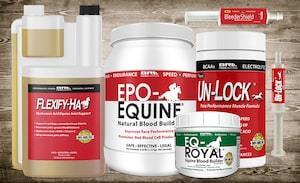
If your performance horse is injured, your vet may recommend stall rest for a few days, weeks or even months. Stall rest restricts your horse’s movement so that he can heal, but suddenly confining a high-energy performance horse to a stall can be a challenge. These five tips can help you help your horse to better cope with stall rest.
Strategically Select a Stall
The stall’s position in the barn can affect how well your horse copes with his time indoors. Some horses do well when they’re in a stall that’s in a busy area of the barn. This position lets the horses see frequent activity and keeps them entertained. Other horses will get worked up by this type of environment and do better in a stall in a quieter area. You may need to try both options to see what works best.
Once you’ve chosen a stall, go through it carefully to look for potential safety issues. With your horse spending an extended period of time in the stall, he’s more likely to play with things that you may have previously overlooked. Examine the stall for broken or loose boards, sharp edges on your horse’s feed or water buckets, loose windows, lights or electrical outlets within reach or a door latch that may be weak or in need of repair.
Keep an Equine Buddy Around
Your horse may become distressed when the other horses are turned out each day, leaving him alone in the barn. Try to keep an equine buddy present in nearby stalls, even if you have to rotate their time indoors. If you can’t keep another horse around, a companion animal, like a goat, may help to reassure your horse.
Provide Mental Stimulation
Often, boredom is what causes horses on stall rest to develop negative behaviors, like weaving or wood chewing. The more mental stimulation you can give your horse, the calmer he may be in his stall.
Try to use meals as mental stimulation. Break large meals into smaller, more frequent ones so your horse doesn’t go long periods of time without something to do. Feed hay in small hole hay nets to make each meal last.
You can also add toys to your horse’s stall to give him something to play with. Your horse may enjoy grooming sessions or massages, too.
Make a Small Paddock
Once your veterinarian gives you the approval, you can start to introduce your horse back into turnout, but it’s important to create the right environment for this. You may need to create a small turnout area if one isn’t already available. Sometimes round pens can be adjusted to work, or you may use round pen panels to divide an existing turnout space.
Giving your horse a change of scenery, even when it’s in a small turnout space, can break up the boredom that comes with stall rest and may make him more willing to stand quietly when he does have to return to his stall.
Work With Your Vet
Some horses just don’t cope well with stall rest regardless of how many techniques you try to keep them entertained. If your horse spins, paces, rears and otherwise won’t settle down, call your vet; a sedative may be prescribed to help keep your horse calm so he gets the rest he needs to heal.
While we know that stall rest won’t last forever, our horses don’t. With some creativity and planning, you can help your horse to better cope so that he heals and can leave his stall again as soon as possible.
Top trainers, owners and competitors rely on BRL Equine products to help their horses perform at their very best. You can get the same great results! Our all-natural equine nutritional supplements really work... guaranteed or your money back!





Also in Horse Tips and More
Top 10 Ways to Show Your Horse You’re Thankful For Him
November 01, 2021
View full article →
5 Ways to Prepare Your Barn For Summer
May 03, 2021
View full article →
Your New Spring Horse Health Checklist
March 12, 2021
View full article →